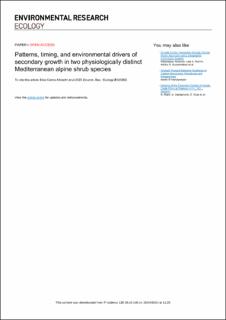| dc.contributor.author | Albrecht, Eike Corina | |
| dc.contributor.author | Dobbert, Svenja | |
| dc.contributor.author | Pape, Roland | |
| dc.contributor.author | Löffler, Jörg | |
| dc.date.accessioned | 2024-04-25T09:21:16Z | |
| dc.date.available | 2024-04-25T09:21:16Z | |
| dc.date.created | 2024-01-31T16:31:19Z | |
| dc.date.issued | 2023 | |
| dc.identifier.citation | Albrecht, E. C., Dobbert, S., Pape, R., & Löffler, J. (2023). Patterns, timing, and environmental drivers of secondary growth in two physiologically distinct Mediterranean alpine shrub species. Environmental Research: Ecology, 2(4), Artikkel 045002. | en_US |
| dc.identifier.issn | 2752-664X | |
| dc.identifier.uri | https://hdl.handle.net/11250/3128077 | |
| dc.description.abstract | Alpine plants are particularly sensitive to climate change, and in the Mediterranean, less frequent winter cold and prolonged summer drought are expected to shift the growth patterns of species, altering their range and strategies to cope with these dual climatic stressors. However, adaptive strategies for drought and frost and their impact on performance of species are poorly explored, with critical timescales relevant for growth insufficiently reflected and a focus on a limited set of environmental drivers. Here, we explored the growth processes of two physiologically distinct Mediterranean alpine shrub species: Cytisus galianoi (green-stemmed species) and Astragalus granatensis (dimorphic species). By measuring the daily stem diameter changes of 26 specimens over six consecutive years (2015–2020) using dendrometers, as well as the corresponding soil temperature and soil moisture conditions, we identified bimodal annual growth patterns (i.e. two phases of growth), water-related timing of growth, and drought- and frost-related environmental constraints. By implementing correlation analyses, linear mixed effects models, and partial least-squares regression, we found pregrowth temperature and moisture drivers to be highly relevant for growth in both species, suggesting a temporal decoupling of growth and resource acquisition. However, the underlying mechanisms were contrasting. While the spring growth of C. galianoi was promoted by pregrowth winter conditions, the autumn growth of A. granatensis was promoted by pregrowth summer conditions. Thus, resource acquisition is likely to be optimized when the traits of species allow physiological activity at high gain and low costs, i.e. when adaptive mechanisms reduce resource consumption to cope with frost and drought. This is during winter for frost-tolerant green-stemmed species and during summer for drought-avoidant dimorphic species, leading to species-specific time windows of growth. Understanding these species-specific growth mechanisms contributes to answering the overarching question of when and how woody plants grow and helps in understanding their adaptability to future climate variability, particularly in sensitive alpine environments, where plant species are evolutionally adapted to physical peculiarities and reach their low-temperature limit. | en_US |
| dc.language.iso | eng | en_US |
| dc.rights | Navngivelse 4.0 Internasjonal | * |
| dc.rights.uri | http://creativecommons.org/licenses/by/4.0/deed.no | * |
| dc.title | Patterns, timing, and environmental drivers of secondary growth in two physiologically distinct Mediterranean alpine shrub species | en_US |
| dc.type | Peer reviewed | en_US |
| dc.type | Journal article | en_US |
| dc.description.version | publishedVersion | en_US |
| dc.rights.holder | © 2023 The Author(s). | en_US |
| dc.source.volume | 2 | en_US |
| dc.source.journal | Environmental Research: Ecology | en_US |
| dc.source.issue | 4 | en_US |
| dc.identifier.doi | https://doi.org/10.1088/2752-664X/acffcc | |
| dc.identifier.cristin | 2240647 | |
| dc.source.articlenumber | 045002 | en_US |
| cristin.ispublished | true | |
| cristin.fulltext | original | |
| cristin.qualitycode | 1 | |

